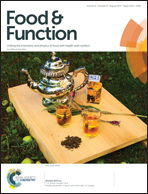Cross-talk between 10-gingerol and its anti-cancerous potential: a recent update
Abstract
Since time immortal, ginger, as an ancient herb, has been used throughout the world in foods and beverages due to its typical strong and pungent flavor. Besides its use as a spice, it also serves as an excellent source of several bioactive phenolics, including nonvolatile pungent compounds, such as gingerols, paradols, shogaols, and gingerones. Gingerols constitute key ingredients in fresh ginger, with the most abundant being 6-gingerol (6-G), 8-gingerol (8-G), and 10-gingerol (10-G). Many studies have investigated the various valuable pharmacological properties of these ingredients and experimentally verified the mechanistic aspects of their health effects; however, to date, most research on the anti-cancerous activities of gingerols have focused largely on 6-G. Thus, the present article deals with the number of recent studies that have indicated and highlighted the role of 10-G with respect to its cancer prevention attributes in particular and its anti-inflammatory, anti-oxidant, anti-microbial, and gastrointestinal tract protective potential in general. The purpose of this review is to provide an overview of all the experimentally validated health benefits of 10-G for nutraceutical applications. The various findings have warranted the further investigation of 10-G and its possible use in various cancer treatments as well as its promising role as a chemo-preventive agent.



 Please wait while we load your content...
Please wait while we load your content...